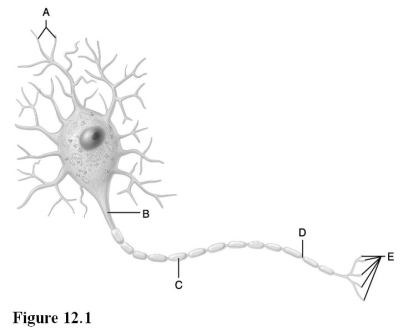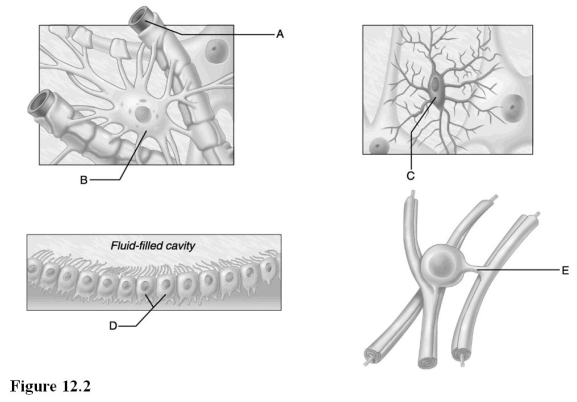A) endoneurium
B) epineurium
C) fascicle
D) perineurium
Correct Answer

verified
Correct Answer
verified
True/False
Microglia are ciliated to help circulate cerebrospinal fluid (CSF).
Correct Answer

verified
Correct Answer
verified
Multiple Choice
Astrocytes perform all of the following functions except
A) regulating levels of neurotransmitters around the neurons
B) controlling ion levels in the environment around neurons
C) help with synapse formation in the developing nervous system
D) produce cerebrospinal fluid
Correct Answer

verified
Correct Answer
verified
True/False
A neuron is a collection of nerve fibers in the PNS.
Correct Answer

verified
Correct Answer
verified
Multiple Choice
Sensory neurons arise primarily from the
A) neural crest.
B) alar plate.
C) basal plate.
D) neural tube.
Correct Answer

verified
Correct Answer
verified
Multiple Choice
These glial cells arise from embryonic white blood cells.
A) ependymal cells
B) microglia
C) oligodendrocytes
D) satellite cells
Correct Answer

verified
Correct Answer
verified
Multiple Choice
Which of the following statements about an axon is false?
A) It is also referred to as a nerve fiber.
B) It has branches.
C) It carries nerve impulses toward the cell body.
D) It has a uniform diameter.
Correct Answer

verified
Correct Answer
verified
Short Answer
________ form the myelin sheaths in the brain and spinal cord.
Correct Answer

verified
Correct Answer
verified
Multiple Choice
 Use the diagram pictured above to answer the following questions.
-Identify the letter that indicates the region of a neuron from which the axon leaves the cell body.
Use the diagram pictured above to answer the following questions.
-Identify the letter that indicates the region of a neuron from which the axon leaves the cell body.
A) A
B) B
C) C
D) D
E) E
Correct Answer

verified
Correct Answer
verified
Short Answer
The simplest of all reflexes, involving just two neurons, is the ________ reflex.
Correct Answer

verified
Correct Answer
verified
Multiple Choice
 Use the diagrams above to answer the following questions.
-Identify which letter represents the most abundant category of glial cells in the CNS.
Use the diagrams above to answer the following questions.
-Identify which letter represents the most abundant category of glial cells in the CNS.
A) A
B) B
C) C
D) D
E) E
Correct Answer

verified
Correct Answer
verified
Multiple Choice
These glial cells surround the cell bodies of sensory neurons within ganglia of the PNS.
A) astrocytes
B) microglia
C) satellite cells
D) Schwann cells
Correct Answer

verified
Correct Answer
verified
Multiple Choice
The covering of a fascicle within a nerve is the
A) endoneurium.
B) perineurium.
C) ectoneurium.
D) epineurium.
Correct Answer

verified
Correct Answer
verified
Short Answer
Nearly all somatic sensory neurons are of this type, based on the classification of the type and number of processes.
Correct Answer

verified
Correct Answer
verified
Multiple Choice
Which of the following is not a characteristic of neurons?
A) longevity
B) inability to divide
C) high metabolic rate
D) ability to survive without oxygen
Correct Answer

verified
Correct Answer
verified
Multiple Choice
Myelin on axons functions to
A) make the axons live longer.
B) store nutrients (fat) for use by the neurons.
C) cover nodes of Ranvier.
D) speed the rate of impulse conduction and insulate neighboring axons from one another.
Correct Answer

verified
Correct Answer
verified
Short Answer
The ________ matter of the spinal cord forms a butterfly-shaped structure.
Correct Answer

verified
Correct Answer
verified
Multiple Choice
A nerve cell is the same as a
A) nerve.
B) nerve fiber.
C) neurilemmocyte.
D) neuron.
Correct Answer

verified
Correct Answer
verified
Short Answer
________ components of the PNS regulate contraction of smooth and cardiac muscle.
Correct Answer

verified
Correct Answer
verified
Multiple Choice
Which cells provide the myelin sheath for neurons in the PNS?
A) astrocytes
B) microglial cells
C) Schwann cells
D) oligodendrocytes
Correct Answer

verified
Correct Answer
verified
Showing 81 - 100 of 112
Related Exams